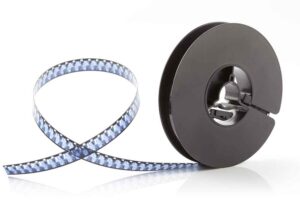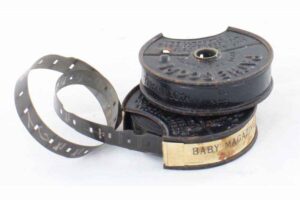info on Ciné Film
-
 8mm
8mm -
 Super 8
Super 8 -
 9.5mm
9.5mm -
 16mm
16mm -
 35mm
35mm
 Standard 8
Standard 8
The standard 8mm film format was developed by the Eastman Kodak company during the Great Depression and released on the market in 1932 to create a home movie format less expensive than 16mm. The film spools actually contain a 16 mm film with twice as many perforations along each edge than normal 16 mm film, which is only exposed along half of its width. When the film reaches its end in the takeup spool, the camera is opened and the spools in the camera are flipped and swapped (the design of the spool hole ensures that this happens properly) and the same film is exposed along the side of the film left unexposed on the first loading.
During processing, the film is split down the middle, resulting in two lengths of 8 mm film, each with a single row of perforations along one edge, so fitting four times as many frames in the same amount of 16 mm film. Because the spool was reversed after filming on one side to allow filming on the other side the format was sometime called Double 8.
The framesize of 8 mm is 4,8 x 3,5 mm and 1 m film contains 264 pictures. Normally Double8 is filmed at 16 frame/s. Kodak ceased producing standard 8 mm film in the early 1990s. Black and white 8 mm film is still manufactured in the Czech Republic, and several companies buy bulk quantities of 16 mm film to make regular 8 mm by re-perforating the stock, cutting it into 25 foot (7.6 m) lengths, and collecting it into special standard 8 mm spools which they then sell. Re-perforation requires special equipment. Some specialists also produce super 8mm film from existing 16mm film stock.
Times based on 16fps
3″ dia. Holds. 50ft of film (4 to 5 mins)
5″ dia. Holds. 200ft of film (16 to 17 mins)
7″ dia. Holds. 400ft of film (33 to 34 mins)

 Super 8
Super 8
Launched in 1965, the film comes in plastic light-proof cartridges containing coaxial supply and takeup spools loaded with 50 feet of film. This was enough for 3 minutes and 20 seconds of continuous filming at 18 frames per second, for a total of 3600 frames. A 200-foot reel later became available which could be used in specifically-designed cameras, but it is no longer produced. Film was almost always a reversal stock.
The plastic cartridge could be loaded into the camera in seconds, without the need to directly thread or even touch the film. In addition, coded notches cut into the cartridge signalled the film speed to the camera to allow automatic film-speed setting.
Colour stocks were generally available only in tungsten (3400K), and almost all Super 8 cameras come with a switchable daylight filter built in, allowing for both indoor and outdoor shooting.
The original release was a silent system only, but in 1973 a sync-sound version was released. The sound film had a magnetic soundtrack, and came in larger cartridges than the original so as to accommodate a longer film path (required for smoothing the film movement before it reached the recording head), and a second aperture for the recording head. Sound cameras were compatible with silent cartridges, but not vice versa. Sound film was typically filmed at a speed of 24 frames per second. Kodak discontinued the production of Super 8 sound film in 1997, citing environmental regulations as the reason.
Times based on 18fps
3″ dia. Holds. 50ft of film (3 to 4 mins
5″ dia. Holds. 200ft of film (13 to 14 mins
7″ dia. Holds. 400ft of film (26 to 27 mins)

 9.5mm
9.5mm
9.5 mm film is an amateur film format introduced by Pathé Frères in 1922 as part of the Pathé Baby amateur film system. It was conceived initially as an inexpensive format to provide copies of commercially-made films to home users, although a simple camera was released shortly afterwards.
It became very popular in Europe over the next few decades and is still used by a small number of enthusiasts today. Over 300,000 projectors were produced and sold mainly in France and England, and many commercial features were available in the format.
The format uses a single, central perforation (sprocket hole) between each pair of frames, as opposed to 8 mm film which has perforations along one edge, and most other film formats which have perforations on each side of the image. The single hole allowed more of the film to be used for the actual image and in fact the image area is almost the same size as 16mm film. The perforation in the film is invisible to viewers as the intermittent shutter blanks off the light as the film is pulled through the gate to the next frame. In most 9.5mm projectors, the shutter also operated once whilst each frame was stationary in the gate to increase the apparent frame rate. In the later sound films, a 1 mm magnetic soundtrack was added, reducing the width of the image by 1 mm.
The width of 9.5 millimeters was chosen because 3 strips of film could be made from one strip of 35 mm film. This was useful when duplicating films because only 1 strip of 35 mm had to be processed. Then the sides, which contained the 35 mm sprocket holes, were cut off, the remaining film was cut into 3 strips, and the central sprocket holes added to each new strip.
The projection system also incorporated a way to save film on non-moving titles. A notch in the film was recognised by the projector which would then project that same frame for 10 seconds. By this method, 10 seconds of screen time was available for 1 frame of film, rather than the 160 frames required if the film was projected at the normal rate.
Times based on 16fps
3″ dia. Holds. 50ft of film 2 minutes
5″ dia. Holds. 200ft of film 8 minutes
7″ dia. Holds. 400ft of film 10 minutes
9″ dia. Holds. 800ft of film 30 minutes

 16mm
16mm
16mm film was initially created in the 1920s as an inexpensive amateur alternative to the conventional 35 mm film format. Thanks to the compact size and lower cost, 16 mm was quickly adopted for use in professional news reporting, corporate and educational films, and other uses, while the home movie market switched to even less expensive 8 mm film.
16 mm was extensively used for television production in countries where television economics made the use of 35 mm too expensive. Digital video tape has made significant inroads in television production use, even to the extent that in some countries, 16 mm (as well as 35 mm) is considered obsolete as a TV production format by broadcasters. Nevertheless, independently produced documentaries and shorts (intended mainly for TV use) may still be shot on film.
Double-sprocket 16 mm film has perforations down both sides at every frame line. Single-sprocket only has perforations on one side of the film. 16mm also has standard and ‘Super’ variations, which is indicative of the aspect ratio it can produce. Standard 16mm has an aspect ratio of 1:37:1, whereas Super 16 has an aspect ratio of 1:66:1.
Times based on 16fps
3″ dia. Holds. 50ft of film (3 to 4 mins)
5″ dia. Holds. 200ft of film (8 to 9 mins
7″ dia. Holds. 400ft of film (16 to 17 mins)

 35mm
35mm
35 mm film is a film gauge used in filmmaking, and the film standard. In motion pictures that record on film, 35 mm is the most commonly used gauge.
The ubiquity of 35 mm movie projectors in commercial movie theaters made 35 mm the only motion picture format that could be played in almost any cinema in the world, until digital projection largely superseded it in the 21st century.
35mm film is commonly shot at 24 frames per second (fps); 90 feet (27 m) per minute. 1,000 feet (300 m) is about 11 minutes at 24 fps.
Times based on 24fps
7″ dia. Holds. 400ft of film (4 to 5 mins)
12.25″ dia. Holds. 1200ft of film (11 to 12 mins)
15″ dia. Holds. 2000ft of film (22 to 23 mins)

-
 8mm
8mm -
 Super 8
Super 8 -
 9.5mm
9.5mm -
 16mm
16mm -
 35mm
35mm
Standard 8
The standard 8mm film format was developed by the Eastman Kodak company during the Great Depression and released on the market in 1932 to create a home movie format less expensive than 16mm. The film spools actually contain a 16 mm film with twice as many perforations along each edge than normal 16 mm film, which is only exposed along half of its width. When the film reaches its end in the takeup spool, the camera is opened and the spools in the camera are flipped and swapped (the design of the spool hole ensures that this happens properly) and the same film is exposed along the side of the film left unexposed on the first loading.
During processing, the film is split down the middle, resulting in two lengths of 8 mm film, each with a single row of perforations along one edge, so fitting four times as many frames in the same amount of 16 mm film. Because the spool was reversed after filming on one side to allow filming on the other side the format was sometime called Double 8.
The framesize of 8 mm is 4,8 x 3,5 mm and 1 m film contains 264 pictures. Normally Double8 is filmed at 16 frame/s. Kodak ceased producing standard 8 mm film in the early 1990s. Black and white 8 mm film is still manufactured in the Czech Republic, and several companies buy bulk quantities of 16 mm film to make regular 8 mm by re-perforating the stock, cutting it into 25 foot (7.6 m) lengths, and collecting it into special standard 8 mm spools which they then sell. Re-perforation requires special equipment. Some specialists also produce super 8mm film from existing 16mm film stock.
Times based on 16fps
3″ dia. Holds. 50ft of film (4 to 5 mins)
5″ dia. Holds. 200ft of film (16 to 17 mins)
7″ dia. Holds. 400ft of film (33 to 34 mins)
Super 8
Launched in 1965, the film comes in plastic light-proof cartridges containing coaxial supply and takeup spools loaded with 50 feet of film. This was enough for 3 minutes and 20 seconds of continuous filming at 18 frames per second, for a total of 3600 frames. A 200-foot reel later became available which could be used in specifically-designed cameras, but it is no longer produced. Film was almost always a reversal stock.
The plastic cartridge could be loaded into the camera in seconds, without the need to directly thread or even touch the film. In addition, coded notches cut into the cartridge signalled the film speed to the camera to allow automatic film-speed setting.
Colour stocks were generally available only in tungsten (3400K), and almost all Super 8 cameras come with a switchable daylight filter built in, allowing for both indoor and outdoor shooting.
The original release was a silent system only, but in 1973 a sync-sound version was released. The sound film had a magnetic soundtrack, and came in larger cartridges than the original so as to accommodate a longer film path (required for smoothing the film movement before it reached the recording head), and a second aperture for the recording head. Sound cameras were compatible with silent cartridges, but not vice versa. Sound film was typically filmed at a speed of 24 frames per second. Kodak discontinued the production of Super 8 sound film in 1997, citing environmental regulations as the reason.
Times based on 18fps
3″ dia. Holds. 50ft of film (3 to 4 mins
5″ dia. Holds. 200ft of film (13 to 14 mins
7″ dia. Holds. 400ft of film (26 to 27 mins)
9.5mm
9.5 mm film is an amateur film format introduced by Pathé Frères in 1922 as part of the Pathé Baby amateur film system. It was conceived initially as an inexpensive format to provide copies of commercially-made films to home users, although a simple camera was released shortly afterwards.
It became very popular in Europe over the next few decades and is still used by a small number of enthusiasts today. Over 300,000 projectors were produced and sold mainly in France and England, and many commercial features were available in the format.
The format uses a single, central perforation (sprocket hole) between each pair of frames, as opposed to 8 mm film which has perforations along one edge, and most other film formats which have perforations on each side of the image. The single hole allowed more of the film to be used for the actual image and in fact the image area is almost the same size as 16mm film. The perforation in the film is invisible to viewers as the intermittent shutter blanks off the light as the film is pulled through the gate to the next frame. In most 9.5mm projectors, the shutter also operated once whilst each frame was stationary in the gate to increase the apparent frame rate. In the later sound films, a 1 mm magnetic soundtrack was added, reducing the width of the image by 1 mm.
The width of 9.5 millimeters was chosen because 3 strips of film could be made from one strip of 35 mm film. This was useful when duplicating films because only 1 strip of 35 mm had to be processed. Then the sides, which contained the 35 mm sprocket holes, were cut off, the remaining film was cut into 3 strips, and the central sprocket holes added to each new strip.
The projection system also incorporated a way to save film on non-moving titles. A notch in the film was recognised by the projector which would then project that same frame for 10 seconds. By this method, 10 seconds of screen time was available for 1 frame of film, rather than the 160 frames required if the film was projected at the normal rate.
- 3″ dia. Holds. 50ft of film 2 minutes
- 5″ dia. Holds. 200ft of film 8 minutes
- 7″ dia. Holds. 400ft of film 10 minutes
- 9″ dia. Holds. 800ft of film 30 minutes
16mm
16mm film was initially created in the 1920s as an inexpensive amateur alternative to the conventional 35 mm film format. Thanks to the compact size and lower cost, 16 mm was quickly adopted for use in professional news reporting, corporate and educational films, and other uses, while the home movie market switched to even less expensive 8 mm film.
16 mm was extensively used for television production in countries where television economics made the use of 35 mm too expensive. Digital video tape has made significant inroads in television production use, even to the extent that in some countries, 16 mm (as well as 35 mm) is considered obsolete as a TV production format by broadcasters. Nevertheless, independently produced documentaries and shorts (intended mainly for TV use) may still be shot on film.
Double-sprocket 16 mm film has perforations down both sides at every frame line. Single-sprocket only has perforations on one side of the film. The picture area has an aspect ratio of 1.33, and there is space for a monophonic soundtrack. Double-sprocket 16 mm stock is slowly being phased out by Kodak, as single-sprocket film can be used by both 16 mm and Super 16 productions.
Times based on 16fps
3″ dia. Holds. 50ft of film (3 to 4 mins)
5″ dia. Holds. 200ft of film (8 to 9 mins
7″ dia. Holds. 400ft of film (16 to 17 mins)
35mm
35 mm film is a film gauge used in filmmaking, and the film standard. In motion pictures that record on film, 35 mm is the most commonly used gauge.
The ubiquity of 35 mm movie projectors in commercial movie theaters made 35 mm the only motion picture format that could be played in almost any cinema in the world, until digital projection largely superseded it in the 21st century.
35mm film is commonly shot at 24 frames per second (fps); 90 feet (27 m) per minute. 1,000 feet (300 m) is about 11 minutes at 24 fps.
Times based on 24fps
7″ dia. Holds. 400ft of film (4 to 5 mins)
12.25″ dia. Holds. 1200ft of film (11 to 12 mins)
15″ dia. Holds. 2000ft of film (22 to 23 mins)

